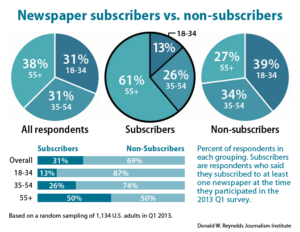Newspapers’ mobile products have two distinctly different audiences
2013 RJI Mobile Media Research Report 6
This report focuses on the use of media tablets and smartphones by newspaper subscribers and non-subscribers.
While newspaper subscribers differed from non-subscribers in most demographic categories, age was the most significant. Our findings revealed how the high percentage of subscribers aged 55 or older and low percentage aged 18-34 skewed subscribers’ usage of smartphones and tablets compared to non-subscribers who are much younger. The average age of subscribers was 56; for non-subscribers it was 43.
Household income was the next most significant difference between subscribers and non-subscribers.
More than half of subscribers said they had annual incomes of $75,000 or more. Only one-third of non-subscribers had incomes in that range.
The income disparity was greatest in the 35-54 age group. Subscribers were more likely than non-subscribers to have incomes of $75,000 or more by a difference of 24 percentage points.
A higher percentage of retired sub-scribers accounts for the difference of 11 percentage points in employment.
Age was a major factor in the use of smart-phones and media tablets by newspaper subscribers.
Subscribers were less likely than non-subscribers to have used smartphones by a difference of 12 percentage points overall. The much higher percentage of subscribers who were aged 55 or older accounted for most of the overall difference.
However, subscribers who had smartphones were just as likely as non-subscribers overall to have used them to consume content on news websites or apps.
Newspaper subscribers younger than age 55 were more likely than non-subscribers of the same ages to have had large tablets, but the overall percentages of all large tablet users in both categories were identical.
We found no statistical difference between subscribers and non-subscribers overall in their use of large tablets for consuming content on news websites or apps.
In both categories, large tablet owners aged 55 or older were more likely to have preferred large tablets over smartphones for news.
The use of smartphones and/or media tablets is clearly influenced by age, income and other demographic characteristics.
What this suggests is that newspaper publishers are dealing with two distinctly different audiences for their mobile products. Mobile products intended primarily for print subscribers will need to appeal to a relatively affluent audience consisting primarily of seniors who are retired or near retirement. Mobile products aimed at non-subscribers will need to focus more on the interests and proclivities of a much younger audience.
***
Apple remained the brand leader for smartphones and large tablets in our 2013 survey.
Among newspaper subscribers who used smartphones, half had Apple iPhones. Eight out of 10 subscribers who used large tablets had an Apple iPad.
Amazon’s Kindle Fire led all other non-Apple brands of large tablets among subscribers and non-subscribers. No subscribers had a Microsoft Surface tablet.
Non-subscribers were more likely than subscribers to have used an Android-powered smartphone, but still had a preference for iPhones.











